uel saver
Page 27
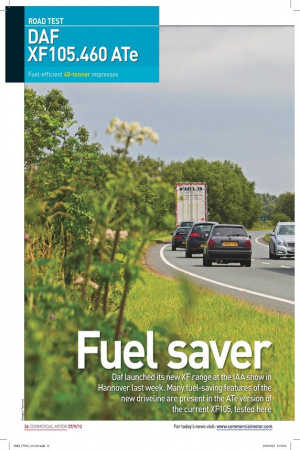
Page 28
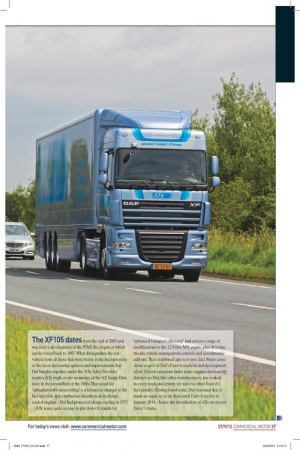
Page 29
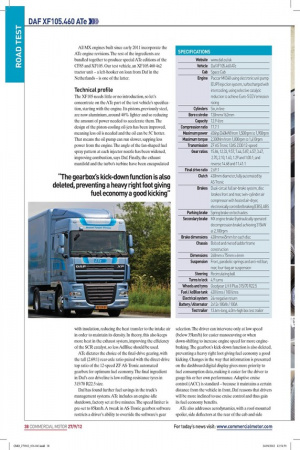
Page 32
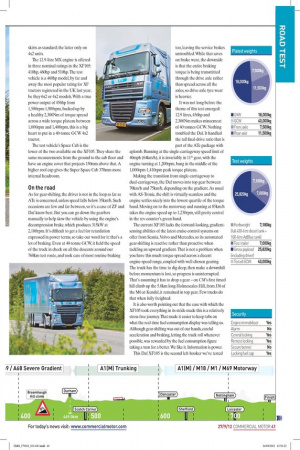
Page 33
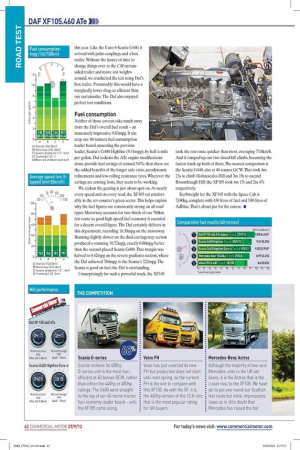
Page 30
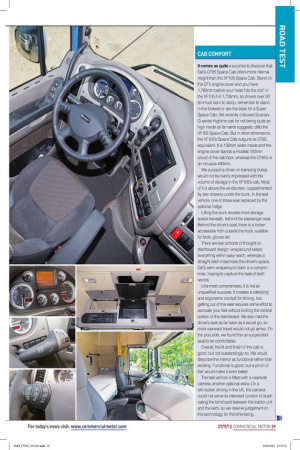
Page 34
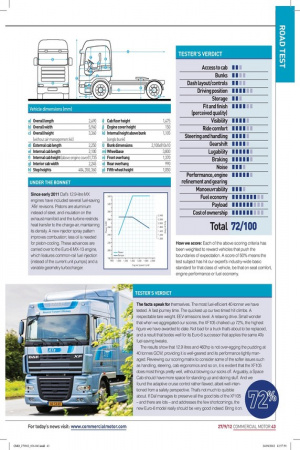
If you've noticed an error in this article please click here to report it so we can fix it.
Daf launched its new XF range at the IAA show in Hannover last week. Many fuel-saving features of the new driveline are present in the ATe version of the current XF105, tested here
The XF105 dates from the end of 2005 and was itself a development of the 95XF, the origins of which can be traced back to 1987. What distinguishes the test vehicle from all those that went before is the incorporation of the latest fuel-saving updates and improvements that Daf bundles together under the ‘ATe’ label. For older readers, ATe might evoke memories of the ATi badge Dafs wore in the second half of the 1980s. That stood for ‘advanced turbo intercooling,’ a reference to changes to the fuel injection and combustion chambers on its chargecooled engines – Daf had pioneered charge-cooling in 1973.
ATe is not quite so easy to pin down. It stands for ‘advanced transport eficiency’ and covers a range of modiications to the 12.9-litre MX engine, plus driveline tweaks, vehicle management controls and aerodynamic add-ons. Their combined aim is to save fuel. Many came about as part of Daf’s Euro-6 research and development effort. Euro-6 emissions limits make engines intrinsically thirstier, so Daf, like other manufacturers, has looked in every nook and cranny for ways to offset Euro-6’s fuel penalty. Having found some, Daf reasoned that it made no sense to sit on them until Euro-6 arrives in January 2014 – hence the introduction of ATe on current Euro-5 trucks. All VIX engines built since early 2011 incorporate the ATe engine revisions. The rest of the ingredients are bundled together to produce special ATe editions of the CF85 and XF105. Our test vehicle, an XF105.460 4x2 tractor unit – a left-hooker on loan from Daf in the Netherlands – is one of the latter.
Technical profile
The XF105 needs little or no introduction, so let’s concentrate on the ATe part of the test vehicle’s speciication, starting with the engine. Its pistons, previously steel, are now aluminium, around 40% lighter and so reducing the amount of power needed to accelerate them. The design of the piston-cooling oil-jets has been improved, meaning less oil is needed and the oil can be 5C hotter. That means the oil pump can run slower, sapping less power from the engine. The angle of the fan-shaped fuel spray pattern at each injector nozzle has been widened, improving combustion, says Daf. Finally, the exhaust manifold and the turbo’s turbine have been encapsulated with insulation, reducing the heat transfer to the intake air in order to maintain its density. In theory, this also keeps more heat in the exhaust system, improving the eficiency of the SCR catalyst, so less AdBlue should be used.
ATe dictates the choice of the inal-drive gearing, with the tall (2.69:1) rear-axle ratio paired with the direct-drive top ratio of the 12-speed ZF AS-Tronic automated gearbox for optimum fuel economy. The inal ingredient in Daf’s eco driveline is low-rolling-resistance tyres in 315/70 R22.5 size.
Daf has found further fuel savings in the truck’s management systems. ATe includes an engine-idle shutdown, factory set at ive minutes. The speed limiter is pre-set to 85km/h. A tweak in AS-Tronic gearbox software restricts a driver’s ability to override the software’s gear selection. The driver can intervene only at low speed (below 35km/h) for easier manoeuvring or when down-shifting to increase engine speed for more enginebraking. The gearbox’s kick-down function is also deleted, preventing a heavy right foot giving fuel economy a good kicking. Changes in the way that information is presented on the dashboard digital display gives more priority to fuel consumption data, making it easier for the driver to gauge his or her own performance. Adaptive cruise control (ACC) is standard – because it maintains a certain distance from the vehicle in front, Daf reasons that drivers will be more inclined to use cruise control and thus gain its fuel economy beneits.
ATe also addresses aerodynamics, with a roof-mounted spoiler, side delectors at the rear of the cab and side skirts as standard; the latter only on 4x2 units.
The 12.9-litre MX engine is offered in three nominal ratings in the XF105: 410hp, 460hp and 510hp. The test vehicle is a 460hp model, by far and away the most popular rating for XF tractors registered in the UK last year, be they 6x2 or 4x2 models. With a true power output of 456hp from 1,500rpm-1,900rpm, backed up by a healthy 2,300Nm of torque spread across a wide torque plateau between 1,000rpm and 1,400rpm, this is a big heart to put in a 40-tonne GCW 4x2 tractor.
The test vehicle’s Space Cab is the lower of the two available on the XF105. They share the same measurements from the ground to the cab loor and have an engine cover that projects 150mm above that. A higher roof cap gives the Super Space Cab 370mm more internal headroom.
On the road
As for gear-shifting, the driver is not in the loop as far as ATe is concerned, unless speed falls below 35km/h. Such occasions are few and far between, so it’s a case of ZF and Daf know best. But you can go down the gearbox manually to help slow the vehicle by using the engine’s decompression brake, which produces 315kW at 2,100rpm. It’s dificult to get a feel for retardation expressed in power terms, so take our word for it: that’s a lot of braking. Even at 40-tonne GCW, it held the speed of the truck in check on all the descents around our 760km test route, and took care of most routine braking too, leaving the service brakes untroubled. While that saves on brake wear, the downside is that the entire braking torque is being transmitted through the drive axle rather than spread across all the axles, so drive-axle tyre wear is heavier.
It was not long before the theme of this test emerged: 12.9 litres, 456hp and 2,300Nm makes mincemeat of 40 tonnes GCW. Nothing troubled the Daf. It handled the tall inal-drive ratio that is part of the ATe package with aplomb. Running at the single-carriageway speed limit of 40mph (64km/h), it is invariably in 11th gear, with the engine turning at 1,200rpm, bang in the middle of the 1,000rpm-1,410rpm peak torque plateau.
Making the transition from single-carriageway to dual-carriageway, the Daf moves into top gear between 70km/h and 75km/h, depending on the gradient. As usual with AS-Tronic, the shift is virtually seamless and the engine settles nicely into the lowest quartile of the torque band. Moving on to the motorway and running at 85km/h takes the engine speed up to 1,230rpm, still pretty central in the rev-counter’s green band.
The current XF105 lacks the forward-looking, gradientsensing abilities of the latest cruise-control systems on offer from Scania, Volvo and Mercedes, so its automated gear-shifting is reactive rather than proactive when tackling an upward gradient. That is not a problem when you have this much torque spread across a decent engine-speed range, coupled with well-chosen gearing. The truck has the time to dig deep, then make a downshift before momentum is lost, so progress is uninterrupted. That’s assuming it has to drop a gear – on CM’s irst timed hill climb up the 5.8km long Holmescales Hill, from J36 of the M6 at Kendal, it remained in top gear. Few trucks do that when fully freighted.
It is also worth pointing out that the ease with which the XF105 took everything in its stride made this is a relatively stress-free journey. That made it easier to keep tabs on what the real-time fuel consumption display was telling us. Although gear-shifting was out of our hands, careful acceleration and braking, letting the truck roll whenever possible, was rewarded by the fuel consumption igure taking a turn for a better. We like it. Information is power.
This Daf XF105 is the second left-hooker we’ve tested
this year. Like the Euro-6 Scania G440, it arrived with palm-couplings and a box trailer. Without the luxury of time to change things over to the CM curtainsided trailer and move test weights around, we conducted the test using Daf’s box trailer. Presumably this would have a marginally lower drag co-eficient than our curtainsider. The Daf also enjoyed perfect test conditions.
Fuel consumption
Neither of those caveats take much away from the Daf’s overall fuel result – an immensely impressive 9.83mpg. It sits atop our 40-tonners fuel consumption leader board, unseating the previous leader, Scania’s G400 Highline (9.31mpg), by half-a-mile per gallon. Daf reckons the ATe engine modiications alone provide fuel savings of around 3.0%: then there are the added beneits of the longer axle-ratio, aerodynamic reinements and low-rolling resistance tyres. Wherever the savings are coming from, they seem to be working.
We reckon the gearing is just about spot on. At nearly every speed and on every road, the XF105 sat comfortably in the rev-counter’s green sector. This helps explain why the fuel igures are consistently strong on all road types. Motorway accounts for two-thirds of our 760km test route so good high-speed fuel economy is essential for a decent overall igure. The Daf certainly delivers in this department, recording 10.30mpg on the motorway. Running slightly slower on the dual-carriageway section produced a stunning 10.72mpg, exactly 0.80mpg better than the second-placed Scania G400. That margin was halved to 0.42mpg on the severe gradients section, where the Daf achieved 7.64mpg to the Scania’s 7.22mpg. The Scania is good on fuel; the Daf is outstanding.
Unsurprisingly for such a powerful truck, the XF105 took the test route quicker than most, averaging 73.8km/h. And it romped up our two timed hill climbs, becoming the fastest truck up both of them. The nearest comparison is the Scania G440, also at 40-tonnes GCW. That took 4m 23s to climb Holmescales Hill and 3m 19s to ascend Broomhaugh Hill: the XF105 took 4m 17s and 2m 47s respectively.
Kerbweight for the XF105 with the Space Cab is 7,180kg, complete with 430 litres of fuel and 100 litres of AdBlue. That’s about par for the course. ■ SPECIFICATIONS Website www.daf.eu/uk Vehicle Daf XF105.460 ATe Cab Space Cab Engine Paccar MX340 using electronic unit pump
(EUP) injection system, turbocharged with intercooling, using selective catalytic reduction to achieve Euro-5 EEV emission rating
Cylinders Six, in line Bore x stroke 130mmx162mm Capacity 12.9-litre Compression ratio 17.7:1 Maximum power 456hp (340kW) from 1,500rpm to 1,900rpm Maximum torque 2,300Nm from 1,000rpm to 1,410rpm Transmission ZF AS Tronic 12AS 2330 12-speed Gear ratios 15.86, 12.33, 9.57, 7.44, 5.87, 4.57, 3.47,
2.70, 2.10, 1.63, 1.29 and 1.00:1; and reverse 14.68 and 11.41:1
Final drive ratio 2.69:1 Clutch 430mm diameter, fully automated by
AS Tronic
Brakes Dual-circuit full air-brake system, disc
brakes front and rear, twin-cylinder air compressor with heated air-dryer, electronically controlled braking (EBS), ABS
Parking brake Spring brake on both axles Secondary brake MX engine brake (hydraulically operated
decompression brake) achieving 315kW at 2,100rpm
Brake dimensions 430mmx45mm for each disc Chassis Bolted and riveted ladder frame
construction
Dimensions 260mm x 75mm x 6mm Suspension Front, parabolic springs and anti-roll bar;
rear, four-bag air suspension
Steering Recirculating ball Turns to lock 4.9 turns Wheels and tyres Goodyear LH II Plus 315/70 R22.5 Fuel / AdBlue tank 430 litres / 100 litres Electrical system 24v negative return Battery / Alternator 2x12v 180Ah / 100A Test trailer 13.6m-long, 4.0m-high box test trailer
CAB COMFORT
It comes as quite a surprise to discover that Daf’s CF85 Space Cab offers more internal height than this XF105 Space Cab. Stand on the CF’s engine cover and you have 1,790mm before your head hits the roof: in the XF105 it is 1,735mm, so drivers over 5ft 8in must learn to stoop, remember to stand in the footwell or ask the boss for a Super Space Cab. We recently criticised Scania’s G-series Highline cab for not being quite as high inside as its name suggests; ditto the XF105 Space Cab. But in other dimensions, the XF105’s Space Cab outguns its CF85 equivalent. It is 135mm wider inside and the engine cover stands a modest 150mm proud of the cab floor, whereas the CF85’s is an intrusive 440mm.
We suspect a driver on tramping duties would not be overly impressed with the volume of storage in the XF105’s cab. Most of it is above the windscreen, supplemented by two drawers under the bunk. In the test vehicle, one of those was replaced by the optional fridge.
Lifting the bunk reveals more storage space beneath, behind the passenger seat. Behind the driver’s seat, there is a locker accessible from outside the truck, suitable for tools, gloves etc.
There are two schools of thought on dashboard design: wraparound keeps everything within easy reach, whereas a straight dash maximises the driver’s space. Daf’s semi-wraparound dash is a compromise, hoping to capture the best of both worlds.
Like most compromises, it is not an unqualified success. It creates a satisfying and ergonomic cockpit for driving, but getting out of the seat requires some effort to extricate your feet without kicking the central portion of the dashboard. We also had the driver’s seat as far back as it would go, so more rearward travel would not go amiss. On the plus side, we found the air-suspended seat to be comfortable.
Overall, the fit and finish of the cab is good, but not outstandingly so. We would describe the interior as functional rather than exciting. Functional is good, but a pinch of flair would make it even better.
The test vehicle is fitted with a nearside camera, another optional extra. On a left-hooker driving in the UK, the camera could not serve its intended function of eradicating the blind spot between the tractor unit and the kerb, so we reserve judgement on this technology for the time-being. THE COMPETITION Scania G-series Scania reckons its 400hp G-series unit is the most fuelefficient at 40 tonnes GCW, rather than either the 440hp or 480hp ratings. The G400 went straight to the top of our 40-tonne tractor fuel economy leader board – until the XF105 came along. Volvo FH Volvo has just unveiled its new FH but production does not start until next spring, so the current FH is the one to compare with this XF105. As with the XF, it is the 460hp version of the 12.8-litre that is the most popular rating for UK buyers. Mercedes-Benz Actros Although the majority of two-axle Mercedes units in the UK are Axors, it is the Actros that is the closer rival to the XF105. We have yet to put one round our Scottish test route but initial impressions leave us in little doubt that Mercedes has raised the bar. Vehicle dimensions (mm UNDER THE BONNET Since early 2011 Daf’s 12.9-litre MX engines have included several fuel-saving ‘ATe’ revisions. Pistons are aluminium instead of steel, and insulation on the exhaust manifold and the turbine restricts heat transfer to the charge-air, maintaining its density. A new injector spray pattern improves combustion; less oil is needed for piston-cooling. These advances are carried over to the Euro-6 MX-13 engine, which features common-rail fuel injection (instead of the current unit pumps) and a variable geometry turbocharger. How we score: Each of the above scoring criteria has been weighted to reward vehicles that push the boundaries of expectation. A score of 50% means the test subject has hit our expert’s industry-wide basic standard for that class of vehicle, be that on seat comfort, engine performance or fuel economy.
TESTER’S VERDICT The facts speak for themselves. The most fuel-efficient 40-tonner we have tested. A fast journey time. The quickest up our two timed hill climbs. A respectable tare weight. EEV emissions level. A relaxing drive. Small wonder that when we aggregated our scores, the XF105 chalked up 72%, the highest figure we have awarded to date. Not bad for a truck that’s about to be replaced, and a result that bodes well for its Euro-6 successor that applies the same ATe fuel-saving tweaks.
The results show that 12.9 litres and 460hp is not over-egging the pudding at 40 tonnes GCW, providing it is well-geared and its performance tightly managed. Reviewing our scoring matrix to consider some of the softer issues such as handling, steering, cab ergonomics and so on, it is evident that the XF105 does most things pretty well, without blowing our socks off. Arguably, a Space Cab should have more space for standing up and storing stuff. And we found the adaptive cruise control rather flawed, albeit well-inten tioned from a safety perspective. That’s not much to quibble about. If Daf manages to preserve all the good bits of the XF105 – and there are lots – and addresses the few shortcomings, the new Euro-6 model really should be very good indeed. Bring it on.
TESTER’S VERDICT
Access to cab III Bunks IIII Dash layout/controls IIII Driving position IIIIII Storage III Fit and finish IIIIII (perceived quality) Visibility IIIII Ride comfort IIIIII Steering and handling IIIII Gearshift IIIII Lugability IIIIII Braking IIIIII Noise IIII Performance, engine IIIIII refinement and gearing Manoeuvrability IIII Fuel economy IIIIIIIII Payload IIIIIIIII Cost of ownership IIIIIIIII Total 72/100










































